1. Bitzer M, Klose U, Geist-Barth B, Nägele T, Schick F, Morgalla M, et al. Alterations in diffusion and perfusion in the pathogenesis of peritumoral brain edema in meningiomas. Eur Radiol. 2002; 12:2062–2076. PMID:
12136325.

2. Cai R, Barnett GH, Novak E, Chao ST, Suh JH. Principal risk of peritumoral edema after stereotactic radiosurgery for intracranial meningioma is tumor-brain contact interface area. Neurosurgery. 2010; 66:513–522. PMID:
20173546.

3. Chang JH, Chang JW, Choi JY, Park YG, Chung SS. Complications after gamma knife radiosurgery for benign meningiomas. J Neurol Neurosurg Psychiatry. 2003; 74:226–230. PMID:
12531956.

4. Chang SD, Adler JR Jr. Treatment of cranial base meningiomas with linear accelerator radiosurgery. Neurosurgery. 1997; 41:1019–1025. discussion 1025-1027PMID:
9361055.

5. Gilbert JJ, Paulseth JE, Coates RK, Malott D. Cerebral edema associated with meningiomas. Neurosurgery. 1983; 12:599–605. PMID:
6877541.

6. Girvigian MR, Chen JC, Rahimian J, Miller MJ, Tome M. Comparison of early complications for patients with convexity and parasagittal meningiomas treated with either stereotactic radiosurgery or fractionated stereotactic radiotherapy. Neurosurgery. 2008; 62(5 Suppl):A19–A27. discussion A27-A28PMID:
18580776.

7. Hasegawa T, Kida Y, Yoshimoto M, Iizuka H, Ishii D, Yoshida K. Gamma Knife surgery for convexity, parasagittal, and falcine meningiomas. J Neurosurg. 2011; 114:1392–1398. PMID:
21128736.

8. Hashiba T, Hashimoto N, Izumoto S, Suzuki T, Kagawa N, Maruno M, et al. Serial volumetric assessment of the natural history and growth pattern of incidentally discovered meningiomas. J Neurosurg. 2009; 110:675–684. PMID:
19061353.

9. Jung KW, Ha J, Lee SH, Won YJ, Yoo H. An updated nationwide epidemiology of primary brain tumors in Republic of Korea. Brain Tumor Res Treat. 2013; 1:16–23. PMID:
24904884.

10. Kan P, Liu JK, Wendland MM, Shrieve D, Jensen RL. Peritumoral edema after stereotactic radiosurgery for intracranial meningiomas and molecular factors that predict its development. J Neurooncol. 2007; 83:33–38. PMID:
17245625.

11. Kim DG, Kim CH, Chung HT, Paek SH, Jeong SS, Han DH, et al. Gamma knife surgery of superficially located meningioma. J Neurosurg. 2005; 102(Suppl):255–258. PMID:
15662820.

12. Kollová A, Liscák R, Novotný J Jr, Vladyka V, Simonová G, Janousková L. Gamma Knife surgery for benign meningioma. J Neurosurg. 2007; 107:325–336. PMID:
17695387.

13. Kondziolka D, Mathieu D, Lunsford LD, Martin JJ, Madhok R, Niranjan A, et al. Radiosurgery as definitive management of intracranial meningiomas. Neurosurgery. 2008; 62:53–58. discussion 58-60PMID:
18300891.

14. Kuhn EN, Taksler GB, Dayton O, Loganathan A, Bourland D, Tatter SB, et al. Is there a tumor volume threshold for postradiosurgical symptoms? A single-institution analysis. Neurosurgery. 2014; 75:536–545. discussion 544-545quiz 545PMID:
25171304.

15. Kuratsu J, Kochi M, Ushio Y. Incidence and clinical features of asymptomatic meningiomas. J Neurosurg. 2000; 92:766–770. PMID:
10794289.

16. Lee CH, Jung KW, Yoo H, Park S, Lee SH. Epidemiology of primary brain and central nervous system tumors in Korea. J Korean Neurosurg Soc. 2010; 48:145–152. PMID:
20856664.

17. Lee SR, Yang KA, Kim SK, Kim SH. Radiation-induced intratumoral necrosis and peritumoral edema after gamma knife radiosurgery for intracranial meningiomas. J Korean Neurosurg Soc. 2012; 52:98–102. PMID:
23091666.

18. Mansouri A, Larjani S, Klironomos G, Laperriere N, Cusimano M, Gentili F, et al. Predictors of response to Gamma Knife radiosurgery for intracranial meningiomas. J Neurosurg. 2015; 1–7.

19. Nakamura M, Roser F, Michel J, Jacobs C, Samii M. The natural history of incidental meningiomas. Neurosurgery. 2003; 53:62–70. discussion 70-71PMID:
12823874.

20. Novotný J Jr, Kollová A, Liscák R. Prediction of intracranial edema after radiosurgery of meningiomas. J Neurosurg. 105(Suppl):2006; 120–126. PMID:
18503344.

21. Olivero WC, Lister JR, Elwood PW. The natural history and growth rate of asymptomatic meningiomas : a review of 60 patients. J Neurosurg. 1995; 83:222–224. PMID:
7616265.

22. Osawa T, Tosaka M, Nagaishi M, Yoshimoto Y. Factors affecting peritumoral brain edema in meningioma : special histological subtypes with prominently extensive edema. J Neurooncol. 2013; 111:49–57. PMID:
23104516.

23. Ostrom QT, Gittleman H, Farah P, Ondracek A, Chen Y, Wolinsky Y, et al. CBTRUS statistical report : primary brain and central nervous system tumors diagnosed in the United States in 2006-2010. Neuro Oncol. 15(Suppl):2013; ii1–ii56. PMID:
24137015.
24. Oya S, Kim SH, Sade B, Lee JH. The natural history of intracranial meningiomas. J Neurosurg. 2011; 114:1250–1256. PMID:
21250802.

25. Patil CG, Hoang S, Borchers DJ 3rd, Sakamoto G, Soltys SG, Gibbs IC, et al. Predictors of peritumoral edema after stereotactic radiosurgery of supratentorial meningiomas. Neurosurgery. 2008; 63:435–440. discussion 440-442PMID:
18812954.

26. Pollock BE, Stafford SL, Link MJ, Brown PD, Garces YI, Foote RL. Single-fraction radiosurgery of benign intracranial meningiomas. Neurosurgery. 2012; 71:604–612. discussion 613PMID:
22710378.

27. Santacroce A, Walier M, Régis J, Liščák R, Motti E, Lindquist C, et al. Long-term tumor control of benign intracranial meningiomas after radiosurgery in a series of 4565 patients. Neurosurgery. 2012; 70:32–39. discussion 39PMID:
21765282.

28. Sheehan JP, Lee CC, Xu Z, Przybylowski CJ, Melmer PD, Schlesinger D. Edema following Gamma Knife radiosurgery for parasagittal and parafalcine meningiomas. J Neurosurg. 2015; 26:1–7.

29. Singh VP, Kansai S, Vaishya S, Julka PK, Mehta VS. Early complications following gamma knife radiosurgery for intracranial meningiomas. J Neurosurg. 93(Suppl):2000; 57–61. PMID:
11143263.

30. Stafford SL, Pollock BE, Foote RL, Link MJ, Gorman DA, Schomberg PJ, et al. Meningioma radiosurgery : tumor control, outcomes, and complications among 190 consecutive patients. Neurosurgery. 2001; 49:1029–1037. discussion 1037-1038PMID:
11846894.

31. Stevens JM, Ruiz JS, Kendall BE. Observations on peritumoral oedema in meningioma. Part II : Mechanisms of oedema production. Neuroradiology. 1983; 25:125–131. PMID:
6888712.
32. Unger KR, Lominska CE, Chanyasulkit J, Randolph-Jackson P, White RL, Aulisi E, et al. Risk factors for posttreatment edema in patients treated with stereotactic radiosurgery for meningiomas. Neurosurgery. 2012; 70:639–645. PMID:
21904263.

33. Yano S, Kuratsu J. Kumamoto Brain Tumor Research Group. Indications for surgery in patients with asymptomatic meningiomas based on an extensive experience. J Neurosurg. 2006; 105:538–543. PMID:
17044555.

34. Yoneoka Y, Fujii Y, Tanaka R. Growth of incidental meningiomas. Acta Neurochir (Wien). 2000; 142:507–511. PMID:
10898357.

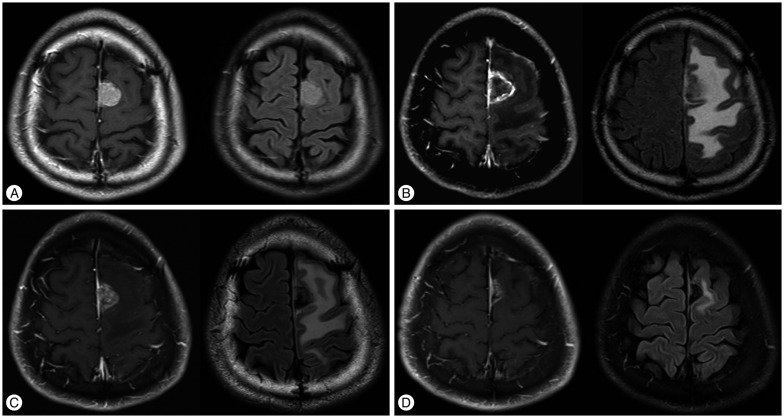




 PDF
PDF ePub
ePub Citation
Citation Print
Print


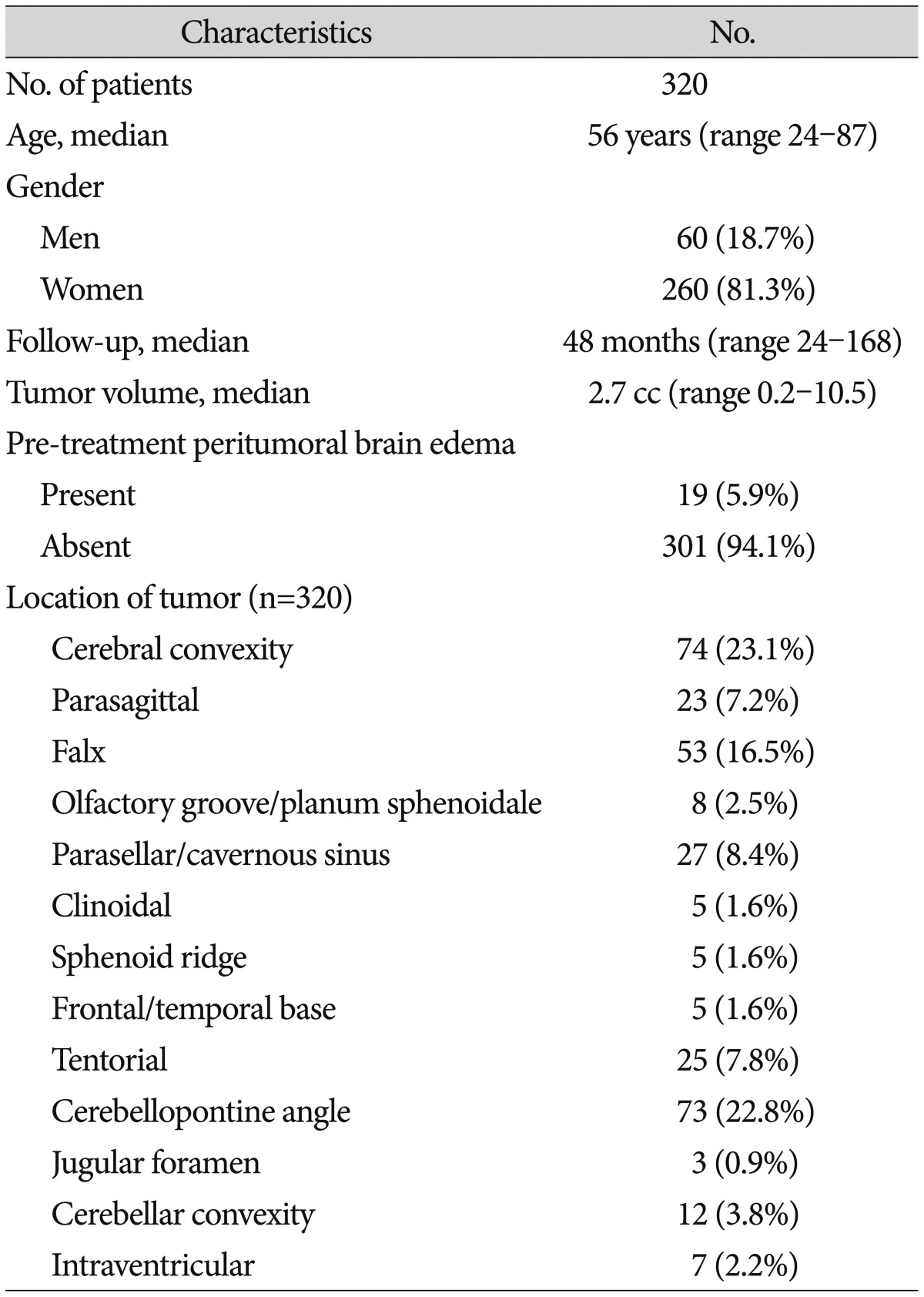
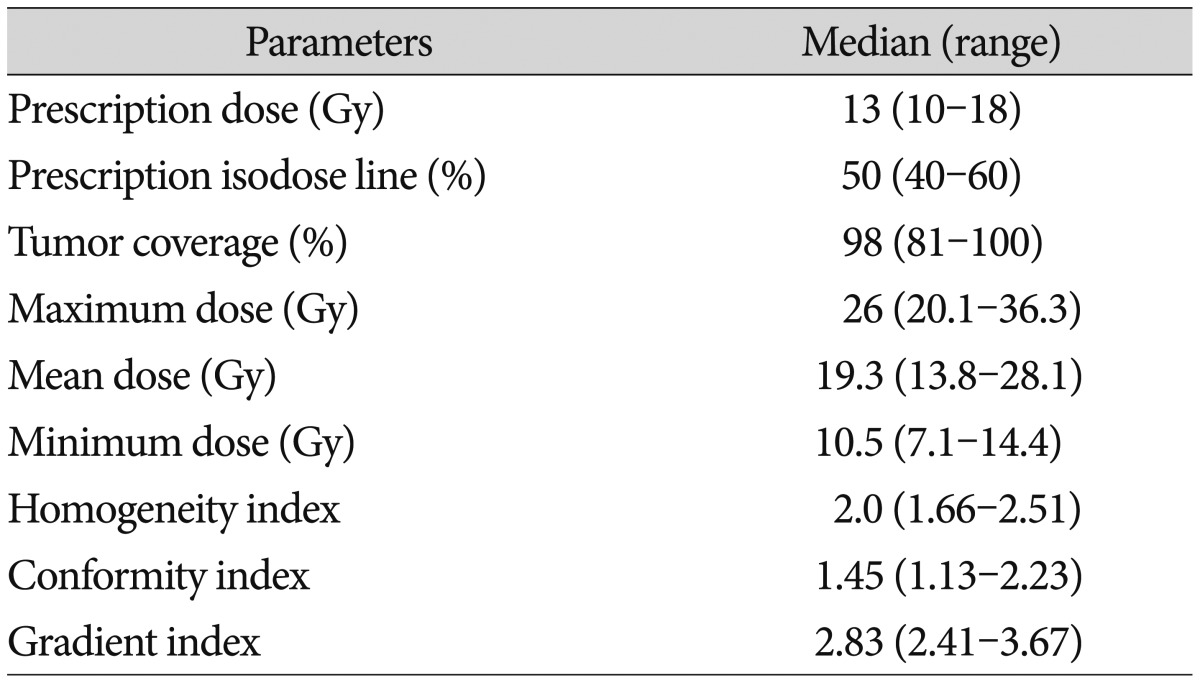
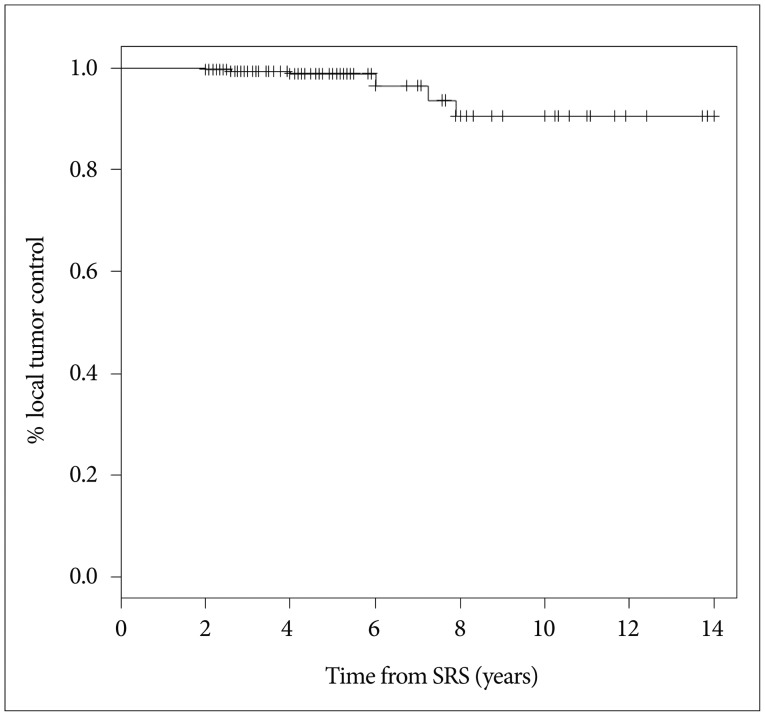
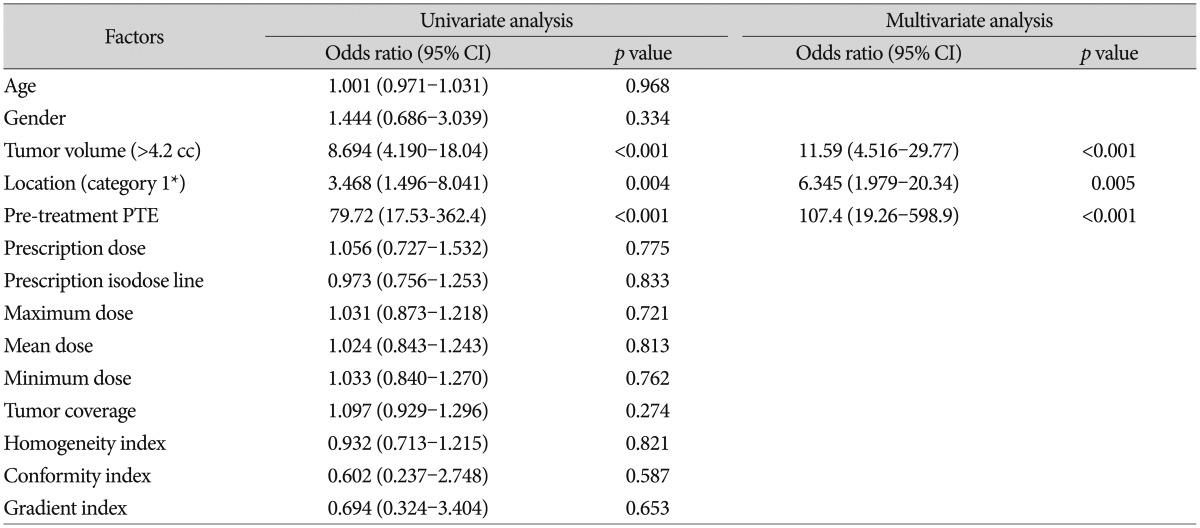
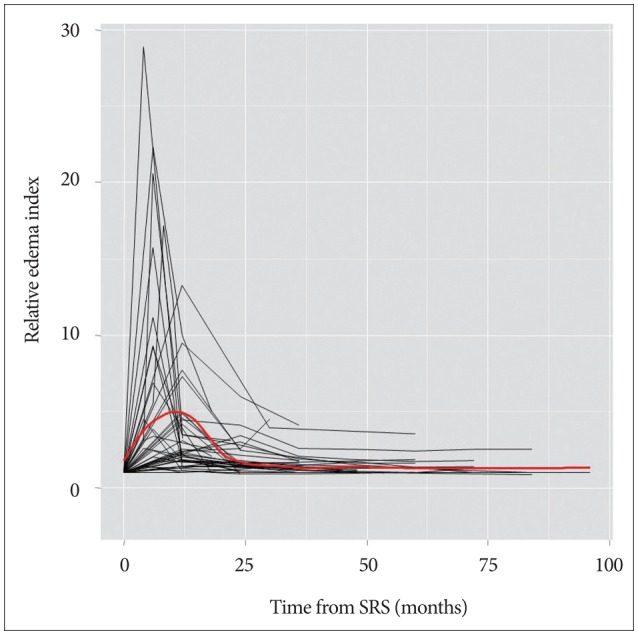
 XML Download
XML Download